Reg Leavers and his crew, Ian Overheu and Joseph Phelps, had a reputation for courage, tenacity and determination which was amply demonstrated in the citation marking the award of the Distinguished Flying Medal (DFM) to Leavers and Overheu. It reads:

Distinguished Flying Medal
747560 Sergeant Evered Arthur Reginald Leavers, No 21 Squadron. NZ40729 Sergeant Ian Overheu Royal New Zealand Air Force, No 21 Squadron.
In April 1941, Sergeant Leavers and Sergeant Overheu were the pilot and observer respectively in an aircraft which participated in an attack on a large enemy convoy. In the face of heavy anti-aircraft fire, Sergeant Leavers displayed great determination and tactical ability which enabled Sergeant Overheu to score two direct hits on a large ship. In March 1941, these airmen successfully attacked an enemy destroyer which was escorting a convoy of some 13 ships. Pressing home his attack from an extremely low-level, Sergeant Leavers machine-gunned the deck while Sergeant Overheu scored two direct hits on the destroyer with his bombs. These airmen have completed many operational missions and both have displayed outstanding team work, together with great courage and determination.”
It is perhaps, a reflection of the times, that Reg Leavers’ Wireless Operator/Air Gunner (WOp/AG) Joseph Phelps went unmentioned, but to many of that trade, it often felt as though they were there as ballast and simply along for the ride, playing no active part in attacks such as the one for which the other two crew members are recognised.
However, if you had a Bf 109 chasing your tail or needed a bearing for home from the RDF station then the WOp/AG was everybody’s friend!
But the impression one gets from the photographs passed to us by Michael Abbot, from Reg Leavers’ then fiancée, Peggy Stanton (formerly Chalmers), is that this crew were a team that flew together, played together and given their reputation for bravery, predictably, died together. Regrettably, this happened time and time again to the Blenheim crews of No 2 Group, Bomber Command.
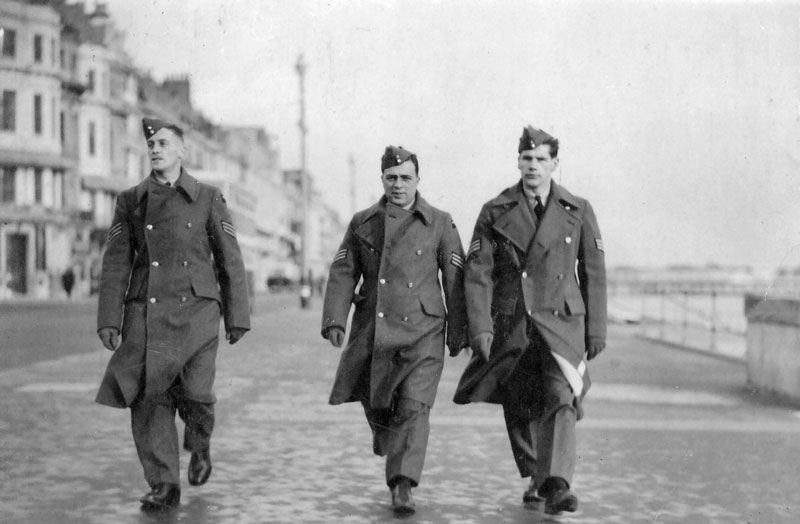
Reg Leavers (his mother always called him Rex) was born on the 27th of May 1917, in Bridgford, Nottingham. He was the only son of Evered Herbert Leavers and Jessie Leavers. Reg’s father was a Lance Corporal in the 10th Training Reserves A Company (unknown regiment). It would appear that his parents’ marriage had faltered, and they had separated while Reg was growing up.
Reg had a sister, Daphne, and both lived with their mother up to the time he joined the RAF.
He attended Lady Bay Primary School, Trent Boulevard, West Bridgford, leaving school at the age of 14 after which he went to work for the Boots Pure Drug Company at Beeston Nottingham in a laboratory associated with the testing of drugs. His sister Daphne worked at another of Nottingham’s leading employers, Raleigh the cycle manufacturers.
Reg was a good looking young man of medium build, good at art and had many friends. He and his sister had managed to buy a small car which they shared and which he no doubt used to get to local dances which he very much enjoyed.
It is thought he joined the RAFVR in 1939 as he wanted to fly with the RAF, learning to fly at Tollerton airfield.
Peggy and Reg were devoted to one another and just before he was called up, Reg drove down to see Peggy when she was on holiday in Skegness! They were engaged on the 4th of October 1940, and had bought rings for each other. Peggy had Reg’s ring engraved with his initials and it is visible in one of the photographs of him when in Malta. Doubtless he was wearing it when he died.
21 Squadron’s Operations Record Books (ORB) for the middle of 1941 give testimony to the pressure crews were working under at the time. For example, Leavers and crew are recorded as having flown on the 4th, 6th, 8th, 10th, 12th, 14th and 18th of April and they weren’t done yet. The late Colin Waugh, who compiled a history of 21 Squadron, as yet unpublished, wrote:
On 20 April 1941, ‘Attie’ Atkinson took five crews with him on detachment to Malta . . . The long trek was made in two stages, flying via Gibraltar and then to Luqa airfield, because of the Blenheim’s limited range. They had been sent to the the island to test out the feasibility of using its airfields as anti-shipping bases in the Mediterranean where the Axis navies were having things much their own way. 21 Squadron hoped to change all that.
And then later he writes
The 10 May saw Squadron Leader Atkinson and his intrepid detachment return from Malta with sun-tanned bodies and a wealth of stories about the punishment being endured by the besieged islanders. On the return flight Atkinson blotted his copy book by running out of fuel as they crossed the coast, and he had to make an emergency landing in a corn field, much to the annoyance of the farmer. The short, successful stay had proved it was possible to operate Blenheims from Malta and plans were drawn up by No 2 Group to do just that.
It would seem that Leavers, Overheu and Phelps were one of the crews on that detachment. But it was no sunshine holiday! It is well documented that to be posted to Malta was pretty much a death sentence, and when 21 Squadron finally detached there formally they were decimated resulting in the Squadron being disbanded and reformed the next day at Bodney with ex-82 Squadron battle-weary Blenheims and a couple of Venturas.

Reg saw Peggy on his leaves from the RAF and she remarked that his personality changed markedly after the period he spent on operations from Malta and she also noted that while on leave, after Malta, Reg was exhausted.
The whole crew reappears in the ORB on the 4th June 1941, flying from Lossiemouth, then again on the 10th & 12th, and then their last operation was on the 16th June from Watton.
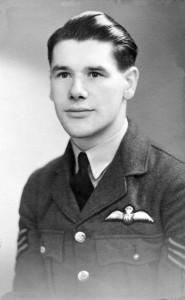
We can never know what went through Reg Leavers’ mind as he climbed aboard his Blenheim, V6034 YH-D, but it would be a fair guess that at least some of his thoughts were of his fast approaching wedding to Peggy. This was his 30th operation and on his return, a rest, a wedding and very probably a welcome change of duties awaited him.
But I think we can be sure that once the first engine burst into life, professionalism and a cool head took over as he ran through the many checks needed prior to flight.
Close by were at least two other aircraft V6240 YH-B and V5651 YH-J and as they lined up for take-off around 1315, Leavers would have checked with his WOp/AG and Observer one last time and advanced the throttles, rolling the Blenheim across the grass at Watton and lifting off into the Norfolk skies one more time.
At this point Sgt Ben Nunn, WOp/AG in YH-J, writing to Colin Waugh well after the war takes over the story . . .
“I crewed up with Pilot Officer Freddy Reiss and navigator, Pilot Officer Edmund Shewell at 17 OTU, Upwood. We were posted to 21 Squadron at Watton on 9 June 1941 and three days later took Blenheim V6361 (F) to Lossiemouth for low-level bombing and formation practice.
“We returned to Watton in V5651 and, the following day (16th June), took off on our first op with two other Blenheims for an anti-shipping sweep off the Friesians near Norderney.
“Sergeant Taylor led Sergeant Leavers and ourselves, out over the North Sea and after an hour’s search, we went down to zero feet. Taylor warned us to prepare to attack a small patrol vessel he had spotted ahead of us. We went in line-astern with our Blenheim being the last to bomb.”
(You can read more about Reiss, Shewell and Nunn in Rusty Russell’s biography of them.)
Because 2 Group’s strikes on German shipping had continued, even in the face of heavy losses, the Germans had begun to equip small patrol vessels with radio transmitters. These vessels were codenamed ‘Squealers’, and were used as an early warning screen to spot the Blenheims well before the convoys were reached. This allowed defending fighters to be ‘scrambled’ and gave the Flak-ships’ crews time to prepare for the attack.
As a result, permission, indeed encouragement, was given to sink these small vessels, as and when the opportunity arose. And this was just one such target of opportunity.
The first to bomb was YH-B crewed by Sgt William Taylor, Sgt Ronald Newman and Sgt Davy Russell. Writing to Colin Waugh as well, Davy Russell, who was a good friend of Reg Leavers, gives us a feel of just what it was like to be a WOp/AG on anti-shipping strikes as he describes the sensations he felt.
It is important to understand that he is not referring to this operation, but a previous one with his regular, Sergeant Pilot Lloyd Butcher (RCAF) from Solsgirth, Manitoba – alias ‘Butch’ and Sergeant Navigator John King from Gloucester – alias ‘Johnny’ . . .
“. . . It seemed to me that from 1941 onwards I had been engaged on my own personal Dunkirk, I always seemed to have my back to the enemy. A shortage of fighter escort had invariably ensured that 21 Squadron had carried out its daylight, low-level sweeps without protection and the mortality rate had been frighteningly high.
“A three minute beat-line looking for shipping off the coast of Norway, Holland or France, with the German Me 109’s and 110’s within spitting distance, had reduced me to a frightened passenger. When we came across any ships, they were almost invariably protected by flak-ships equipped with batteries of cannon, referred to as ‘Chicago pianos’. All hell would then break loose and the pilot had to take violent evasive action as he approached the target at zero feet. He then dropped his four bombs at mast height, these being fitted with eleven second delay fuses to allow escape for the aircraft.
“The crazy aerobatics had then to be maintained at top speed after the attack. The airgunner was supposed to strike terror in the hearts of the enemy by spraying everything in sight with his armour-piercing Brownings. On my first sortie off the Friesians, I had sincerely attempted to follow instructions. Flying at wavetop height to fox the enemy radar listeners, the formation of nine Blenheims found the ships so abruptly that I was jolted, unceremoniously, into the harsh reality of operational flying.”
‘Butch’ threw the aircraft in all directions to assure himself of a safe return to Canada at the end of his tour of ops. His dumbfounded air gunner was bounced madly up and down, and from side to side, like a marble in a box . . .
“My head struck the top of the turret, my rear end skating off the saddle, my chin gashed and bleeding. I caught a momentary glimpse of a ship over to the left, but it seemed to have taken off and appeared to be flying higher than me. The world wheeled around us in chaotic fashion – sea, sky, ship, sky! My eyes startled out of my head as we whipped by the terrified, open-mouthed face of a sailor in the crow’s nest at almost touching distance. I knew that ‘Johnny’ must have switched on the siren under the nose of the plane, but I could not hear it for the scream of the engines.
“I endeavoured to look through the gunsight but the attempt was fruitless; it was as if someone had seized me by the hair and was trying to shake my head free from its shoulders. I managed to loose off one, blind burst just as the Blenheim lurched drunkenly to port with its wingtip threatening to bury itself in the sea. I knew the burst had spent itself harmlessly in the wide open sky.
“Up front, amazed that he had appeared to have escaped an early death, ‘Butch’ righted the plane.
‘Did I hit her Dave? Did I hit the bastard?’, he yelled over the intercom.
I lost my temper.’ Hit her! Hit her! How the hell would I know if you hit her! I was too busy attempting to keep myself in one piece while you were trying to pull the control column out by the bloody roots! Christ, I thought the Germans were the enemy, not the flamin’ Canadians!’
‘Well, Christ, can’t you see her now?’, shouted ‘Butch’.
‘Yes, hold on! Yes! One of them’s got smoke coming from the deck. At least one of them has been hit’
‘Great. Bloody marvellous! Wonder was it me that hit her? Jeez, I’m gonna go back to have a look.’
‘Johnny’ was quick to intervene. ‘For God’s sake move this bloody ‘kite’ before the Me 109’s are up our arse!’
‘Butch’ was restored to sanity. Wing Commander Webster had expressly ordered that no-one should linger near the scene of the crime. A Blenheim on its own was a sitting duck and an easy victim, even for a ‘sprog’ pilot in the Luftwaffe.
We now return to the the operation pictured here.
Just seconds behind Taylor in YH-B, was Leavers in YH-D closing in on the ship with Joseph Phelps in the turret, perhaps feeling as useless as Davy Russell described. In the nose Ian Overheu took up his position looking out of the direct vision glass panel with his hand on the switch that would release the bombs.
Leavers squared up for his attack on the Squealer, following the line of Taylor in front. He would have released his bombs to slam into the side of the ship, just above the water-line, when . . .
Behind them was YH-J piloted by Freddy Reiss, with Observer Edmund Shewell and WOp/AG Ben Nunn who takes up the story again . . .
“We went in line-astern with our Blenheim being the last to bomb. I took a photo of this action and Leavers’ bombs hit home but his aircraft lost a wingtip when it struck the mast of the ship and I ‘snapped it’ just before the Blenheim flipped over and dived into the sea. Freddy had to swerve violently to avoid colliding with it.”
Even by the standards of 1941, dropping bombs from a Blenheim was terribly primitive. The bomb bay doors were essentially plywood panels held shut by elastic straps (or bungee cord). Bombs previously held in the bomb bay by the ‘bomb carrier’, when ‘released’ by the Observer or Pilot, fell out of the aircraft pushing their way through the doors by sheer weight alone. The bomb bay doors then slammed shut by the action of the bungee cords.
There is no doubt about what the outcome of this attack was, a large section of the starboard wing was removed from Leavers’ aircraft, it flipped over and plummeted into the sea. Flt Sgt Reg Leavers DFM, Sgt Ian Overheu DFM and Sgt Joseph Phelps must have all died instantly.
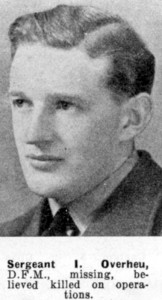
Reg Leavers’ body washed ashore some time later on the coastline outside the sea dike of North Groningen and his remains are buried at Baflo (Den Andel) Protestant Cemetery Row 22 Grave 12,
Joseph Phelps’ body washed ashore on the German coast and is buried in the Sage War Cemetery in the north of Germany approx 56kms west of Bremen, grave reference 7. c. 15
Ian Overheu’s body was never recovered and he is remembered on Panel 64 of the Runnymede Memorial near Windsor.
But what of the two surviving aircraft? Again we return to Benn Nunn for what happened next . . .
” On our way home, still at low-level, all was serene and I had started on my chocolate ration when suddenly bullets were flying everywhere; and so was my chocolate bar. We were under attack from two Me 109’s coming at us alternately and diagonally and this went on for some thirty minutes. During this time my guns jammed and a cannon shell went through my parachute, though what good would it have been anyway, at fifty feet?
” An armour piercing bullet then damaged the TR9 set which meant I could not advise Freddy when to take evasive action. As a result of this combat all the hydraulics were damaged and we did a ‘belly-landing’ at Sutton Bridge. I thought, ‘this will be bloody exciting if all sorties go like this one’.
“We were picked up by Squadron Leader Partridge in V6240, about an hour later, taken back to Watton, and debriefed. I remember being given a pill by the MO which put me to sleep for 24 hours.”
I will leave the last comment to Davy Russell, WOp/AG on the lead aircraft
“The enemy held all the cards on all occasions. On these daylight raids, it seemed to me that I merely fulfilled the function of ballast, that perhaps my presence in the turret enhanced the trim of the aircraft. In the target area I was next to useless, I simply sat on my tin hat, shut my eyes, held grimly onto the turret control and tried to ride out the buffeting. The tin hat was important; I was not married, but hoped to be one day.”
Now for the problems!
There are a couple of inconsistencies in this story if you consult 21 Squadron ORB for the 16th June (AIR 27 / 263) which says (transcribed verbatim)
| A/C No. | Ident | Crew | Time Up | Time Down |
|
6450 |
L |
W/C. Webster, F/O. Robertson, Sgt. Addison |
1319 | 1810 |
|
6398 |
A |
S/L. Partridge, Sgt. Dvorjetz, Sgt. Davies |
1319 | 1813 |
|
6252 |
U |
P/O. Graham-Hogg, Sgt. Pinkney, Sgt. Marsden |
1319 | 1812 |
|
5651 |
J |
P/O. Reiss, P/O. Shewell, Sgt. Nunn |
1319 | 1815 |
|
6034 |
D |
Sgt. Leavers, Sgt. Overheu, Sgt. Phelps |
1319 | – |
|
6240 |
B |
Sgt. Taylor, Sgt. Newman, Sgt. Russell |
1319 | 1950 |
Daylight attack on shipping 2G.0.0.27. OPS 501
Six aircraft of 21 Squadron operating from Watton were detailed to attack shipping off East Frisian Islands. Aircraft A, J and D attacked a patrol vessel of 1500 tons 6 miles North of Borkum. Bomb splashes were seen near the vessel and after bombing a column of black smoke was seen rising from the stern of the vessel is claimed as a total loss. [sic] Aircraft D hit the mast of the vessel during the attack and crashed into the sea. The remaining 3 aircraft were attacked by 2 Me. 109F during the return to base, the engagement lasting 23 minutes. Aircraft B was badly shot up, but made a successful landing at Sutton Bridge the crew being unhurt.
Seems straightforward enough doesn’t it? But let’s examine some of the details.
“Aircraft B was badly shot up, but made a successful landing at Sutton Bridge the crew being unhurt.”
YH-B crew was Sgt Taylor, Sgt Newman, Sgt Russell and their time down is 1950 which is nearly 1 hour 30 minutes after the others. Which might be right but if it was badly shot up, the groundcrews did a remarkable job because it was back in action on 21st June, 3 days later on a Circus to St Omer!
What isn’t recorded in the ORB is the first hand account of Benn Nunn in YH-J who says that THEY belly landed at Sutton Bridge. And YH-J doesn’t appear in the ORB again until 4th July when it is No. 7432. This suggests Nunn’s aircraft was badly damaged and wasn’t returned to service with 21 Squadron.
This implies that the ORB is incorrect on this point and that Nunn is right – as might be expected!
Secondly the ORB narrative says Aircraft A, J and D “attacked a patrol vessel” we know Ben Nunn was in J and Leavers was in D and Ben says it was Taylor in B who led them in to the attack.
If he is correct, we can say that the aircraft in the distance is YH-B with Taylor, Newman and Russell on board but if the ORB is correct then we must believe that it is YH-A with S/L Partridge, Sgt Dvorjetz and Sgt Davies aboard.
And there’s more!
Puzzling in the narrative are the words that say “Six aircraft . . . were detailed to attack shipping . . . Aircraft A, J and D attacked . . .Aircraft D hit the mast of the vessel . . . The remaining 3 aircraft were attacked by 2 Me. 109F during the return to base”. Quite literally, it just doesn’t add up.
Lastly, the ORB has got Leavers’ rank wrong, the Commonwealth War Graves Commission records his rank as Flight Sergeant, a small point perhaps but it does conclude some surprising inaccuracies.
In fact the ORB around these months has more remarkable mistakes. For example, on one raid to Rotterdam Docks on the 16th July 1941 it records all crews down safely when one aircraft, 6240 YH-B, was lost over the target! See Rusty Russell’s account of this, in Mast High Over Rotterdam.
There is also an element of doubt about who took that picture, Ben Nunn says he snapped it, and it looks like it was taken with an F24 camera but he would have had to have taken it ‘over his shoulder’ as the turret will not traverse to face forward. On the other hand, if Edmund Shewell took it then why is there no distortion or superstructure visible?
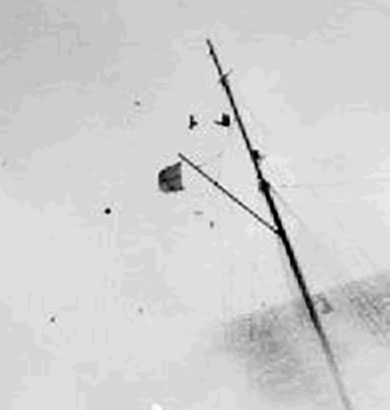
Perhaps it doesn’t matter who took the picture, but I feel that what does matter is the question of what caused Leavers’ aircraft to crash.
All accounts from the time say that Leavers’ aircraft collided with the mast of the vessel under attack, but close inspection (right) of the picture reveals no visible damage to either mast or rigging of the vessel. In particular a flag is still happily flying in the area that he must have hit, had that been the cause.
Only three people could have given the record of what happened – the crew of the following aircraft. Clearly something has ripped away a substantial section of the starboard wing of Leavers aircraft and in that condition the outcome was inevitable.
Personally, I believe the following crew will have been too preoccupied with their own run-in to have been watching Leavers’ attack – it would have been over in an instant – did they just assume the cause of the damage?
The wing of a Blenheim is really quite strong, and travelling at well over 200 miles per hour I find it inconceivable to think that an impact such as this would have left no impression on the vessel.
Could an experienced pilot like Leavers have made such an error? Did he push his luck too far? Was he just tired and got it wrong? Perhaps he did misjudge it and did hit the mast, and perhaps the collision left no damage to the vessel visible in the picture.
Another potential explanation is that his aircraft was damaged by the burst of a bomb dropped by the lead aircraft. The photo clearly shows what is either smoke or spray. The previous bombs will have had an 11-second delay from being dropped to exploding. This was normal. So it seems unlikely that one would have exploded prematurely.
And lastly, could it have been anti-aircraft fire from the vessel or from another unseen vessel?
In the end speculation is just that. But, on a personal note, I do not believe he hit the mast, something else was responsible for the loss of his wing tip.
Postscript
Ian Overheu’s widow, Wyn, stayed with Peggy when the crew was posted as lost and Peggy thinks Wyn may have gone to Australia after the war. Later, Peggy sent a letter to the Air Ministry requesting if they had any details about Reg’s loss. The reply merely states that from captured German documents his body was recovered in Noordpolder on the 30th of June 1941.
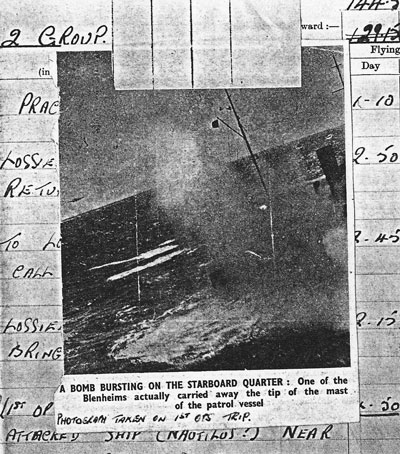
There is just one last picture I would like you to see. Rusty Russell photocopied Ben Nunn’s Log Book and in it, Ben had stuck a paper clipping showing the picture he had taken. I find it a most remarkable and cynical distortion of the truth behind one the saddest pictures I have come across in my years of researching life at RAF Watton.
Notice how all trace of YH-D’s presence has been cropped and erased from the picture and then the caption actually turns a disaster into a positive story!
I leave you to make your own judgement about the merits of that.
Whatever the cause of this crash, there is no doubt in my mind that three incredibly brave men met their end this day and given all the circumstances around it, I feel a particular sadness for the loss of this crew.
In compiling this tribute to the crew of YH-D I would like to thank the following people for their help so freely given to me over the years, Lionel ‘Rusty’ Russell, Colin Waugh, Michael Abbot for the material from Peggy Stanton and for passing on the photographs from her, and Tom Bint and Willem de Jong of 626-squadron.co.uk
With good people like this around the Blenheim Boys will never be forgotten.
Julian Horn, Site Editor and Compiler


Every year on the 4e of May we remember the victims of the second worldwar in our Nationale Dodenherdenking..
In Den Andel we have that memorial at the grave of Sgt Leavers.
In the church we listen to music, there are speeches and we take flowers to the grave.
We like to have contact to relatives, of Sgt Reg Leavers, so we can share the memorial with them.
Thank you
Hello. My uncle was Joseph Howell Phelps. I am interested to know anything about him. My mum was his sister Mildred. Please can anyone help ? Thank you
Thank you.